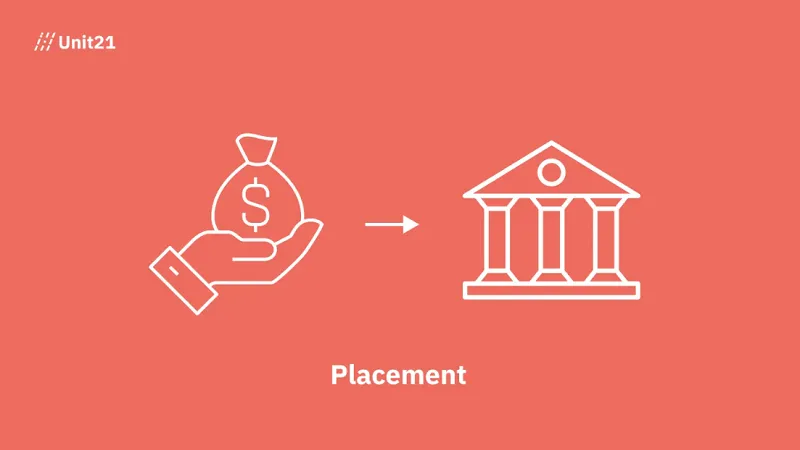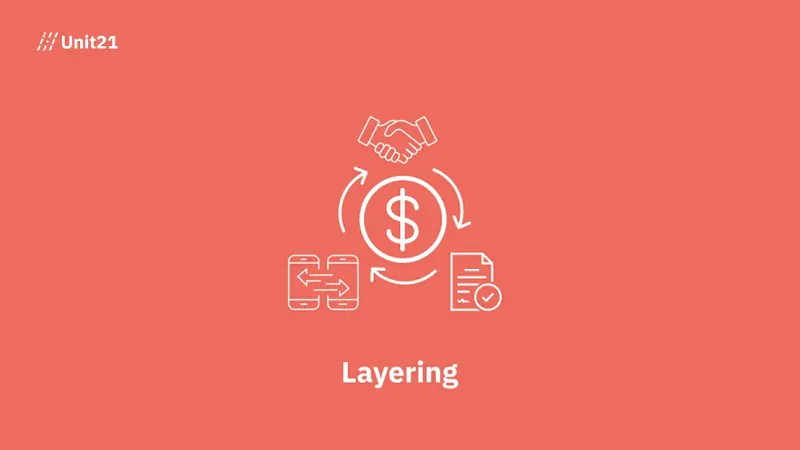

There are many different ways that money laundering can occur, ranging from highly complicated methods to the simplest arrangements. While there are many types of money laundering methods, there are three stages that take place in all cases. For criminals to be able to use the proceeds of crime freely, they first need to obfuscate the source of funds. To do that, money must pass through three phases.
Risk and compliance teams use anti-money laundering controls to prevent money laundering from occurring at the different stages of this process. To help you understand the 3 stages of money laundering—and how you can prevent it—we’ll cover each stage in detail in this section, including:
Money laundering stages are the phases that criminals go through to conceal the original source of funds. This process is used to take funds that were unlawfully obtained, conceal their source of origin, and integrate money back into the legitimate financial system. With the money ‘cleaned,’ it can then be used the same as legal funds.

To get money that has been laundered into the legitimate financial system, there are 3 stages in the money laundering process.
To help you understand the stages—and be able to identify them more readily—we explain each below:
- Placement: The financial system is exposed to ‘dirty money’ during the initial placement stage of money laundering. In this stage, illicit funds are funneled into the financial system (through transactions, transfers, and purchases).
- Layering: The layering stage begins after the money has entered the financial system, during which the launderer moves the money around to disassociate it from its source and conceal the money trail.
- Integration: Money laundering concludes with integrating the proceeds into the legitimate economy, allowing fraudsters to spend without fear of detection.
These are the three stages used to clean illicit funds. Let’s take a deep dive into each stage and understand how money launderers put their criminal proceeds back into the legitimate financial system.
Stage 1. Placement

In this first phase, ‘dirty money’ is introduced into the financial system when it’s moved into a legitimate source of funds. The goal is to filter illicit funds back into the legitimate financial system, so that its source can be disguised.
This is frequently done by dividing large quantities of money into smaller sums, which are harder to detect. Money can be placed directly into a bank account or used to purchase financial instruments like checks or money orders. Money can also be funneled into businesses, such as casinos or cash-intensive businesses, where it’s easy to disguise the origin of funds.
Strategies may include:
- Disguised deposits: Criminals make deposits to a single or several accounts over a period of time, intending to allude the financial institution of the true origin of these funds. This can be done by breaking funds into smaller amounts, and depositing them into a variety of accounts. The funds will later be transferred to accounts that the criminals own.
- Blending of funds: Criminals mix illicit funds with legitimate funds, making it difficult to decipher the difference. This can be achieved by funneling illegitimate funds into cash-intensive businesses that allow criminals to blend cash.
- Cash smuggling: Criminals physically move money internationally, muling money across borders. Money is then funneled into the foreign financial system, and then transferred back to domestic accounts.
- Foreign exchange: Criminals trade or purchase foreign currency using illegitimate funds. This can be done in countries with less strict AML policies, where regulations can easily be skirted.
- Using financial instruments: Criminals purchase financial services, such as money orders, traveler’s checks, or postal orders. These products are then used to deposit the funds into other accounts, adding an additional layer of history to the funds, and obscuring the true source of the funds in the process.
- Purchasing assets: Criminals purchase assets using the proceeds of crime, which they later sell back, receiving legitimate funds. Typically, criminals use high-value assets (such as real estate, vehicles, artwork, or precious metals) to launder larger sums of money, but they can also use smaller asset purchases to achieve the same result.
Stage 2. Layering

In the layering phase, also referred to as structuring, the seemingly legitimate funds are moved around to disguise the original source of the funds. The primary objective of this stage is to obfuscate the true source of funds and confuse authorities about the true origin of the money.
Once this stage is complete, the money will have a seemingly legitimate history, disguising it as legitimate.
This is often achieved by conducting a variety of transactions, transfers, and purchases. Adept money launderers use complex means of layering funds, buying financial products, investing funds into securities, property, and other assets, and then converting funds back into cash in a criminal's account.
Strategies may include:
- Electronic transfers: Criminals will perform a series of transactions, moving money between a series of accounts. This can be done using both personal and business accounts, making it harder to trace the original source of funds.
- Purchasing financial instruments: Criminals buy financial products and services, such as money orders, stocks and bonds, and even life insurance products. These are later converted back into cash—or used to make purchases in the integration stage, disguising the source of the funds.
- Buying and selling assets: Criminals convert money into assets, such as property and investments. The assets can later be converted back to cash, which appears to be entirely legitimate in nature.
- International transactions: Criminals use foreign currencies, exchanges, and accounts to transfer funds or make trades (via stocks or bonds). The intent is to obscure the source of funds by moving funds through various jurisdictions, making it more difficult to trace their true source.
- Using business transactions: Criminals use standard business transactions to hide the origin of funds. This can be achieved through payments for products or services, structuring private loans to other companies, and other means that allow them to make the transactions look credible.
- Cryptocurrency trading: Criminals trade cryptocurrency (and other virtual currencies) due to the perceived anonymity associated with these types of funds. Criminals trade these funds across different platforms, layering the funds and obscuring the history of the funds.
Stage 3. Integration

Money laundering culminates with the integration of the proceeds into the legitimate economy. The money is routed back into the criminal's registered bank accounts, where it can be spent freely.
This often entails a slew of minor transactions, just like earlier stages. The criminal may invest in real estate, luxurious items, or commercial endeavors in order to use the money to make purchases without drawing the attention of law enforcement or the tax authorities.
In many cases, criminals accept a small amount of shrinkage on the original value that was ‘placed’ in the system in the first stage. Fraudsters see this as the cost of ‘cleaning’ the illegal funds.
Strategies may include:
- Transfers back to legitimate accounts: Criminals transfer funds back to their legitimate accounts. This can be done through bank transfers, payment of dividends to shareholders, or through the issuance of a loan (that will never be paid back).
- Selling assets: Criminals sell off assets from the ‘layering’ stage, converting them into legitimate funds within the financial system. The funds now appear to be legitimately sourced, having entered the system through an apparently legitimate transaction.
- Fake salaries: Criminals establish false salaries (sometimes even using fake payroll systems) for non-existent employees, allowing the criminal to receive the funds in a manner that seems legitimate and will not raise suspicions.
Understanding the three stages of money laundering makes organizations aware of the specific strategies behind each stage to understand how to identify it early, and ideally, stop it before it’s complete. Organizations like Unit21 can help automate things such as transaction monitoring to assist with identifying money laundering within these stages.
By understanding these stages, next you should check out our next chapter: How to Combat Money Laundering + Real-Life Examples to Learn From. If you’re still learning the basics, try jumping back to the previous chapter, where we cover the main types of money laundering and what they involve.
Subscribe to our Blog!
Please fill out the form below:
Learn more about Unit21
Unit21 is the leader in AI-powered fraud and AML, trusted by 200 customers across 90 countries, including Green Dot, Chime, and Sallie Mae. One unified platform brings detection, investigation, and decisioning together with intelligent automation, centralizing signals, eliminating busy work, and enabling faster responses to real risk.






.webp)
.png)
.webp)